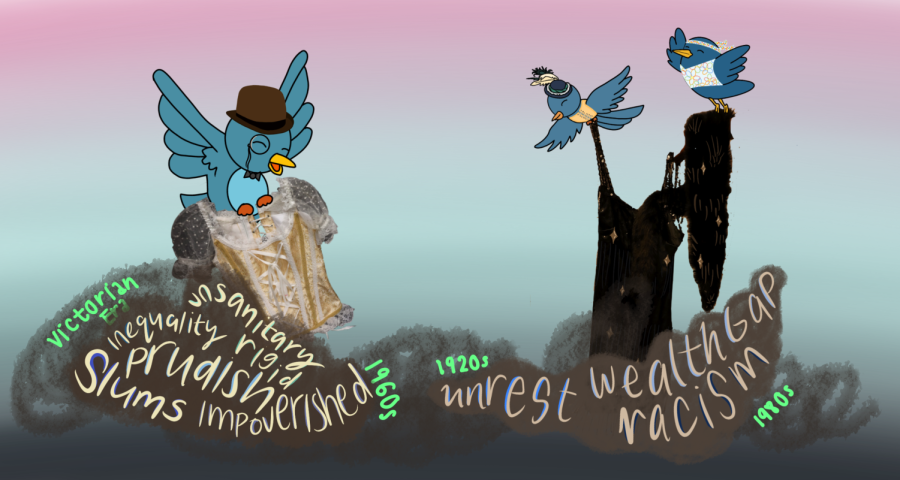Rose-colored romanticization vs. the reality of historical eras
Graphic illustration by In-Depth Section
Popular culture often chooses glamorized depictions and stereotypes of historical eras, ignoring the more nuanced realities of life during them.
February 1, 2022
A web search of “Victorian Era” brings up images of polished women huddled in lavish ballrooms. Likewise, a browse for the “1980s” produces neon graphics and glitzy, shoulder-padded outfits. These depictions often sugarcoat the realities of historical eras, reinforcing flawed ideas of what life was like during them.
Victorian Era (1827 – 1901):
Films set in the Victorian period, such as “Sherlock Holmes” (2009) and “Jane Eyre” (2011), present visuals of high society stocked with corseted gowns and manors. Although the plots are not always joyful, the imagery in these works has created a view of Victorian living as being refined and sophisticated.
In reality, however, there were more nuances to life during the era. As industrialization swept Britain, flocks of people migrated to the cities to find work. London’s population density during the 19th century doubled to 40 people per acre, almost twice the city’s modern-day density. Coupled with poor urban technology, the high population created atrocious living conditions that crammed families of five or six into single rooms that lacked sanitation, left filth on the streets and bred diseases like cholera in the communities.
Outside the home, urban life was also far from luxurious, and workers were treated like disposable capital.
“In cities, there’s a growing service industry providing basic necessities for the growing population, so that consists of most of the working class,” AP U.S. History and World History teacher Steven Roy said. “But at the same time, you have factories where there’s really no safety regulations, and they tend to be dangerous — a lot of open spinning belts, people getting torn apart on machines and things like that.”
Workhouses, institutions intended to support the poor, were established through Britain’s Poor Law of 1834, but they became prison-like facilities where the most vulnerable were subject to abuse. Rigid societal norms also restricted women, labeling them as inferior beings with the sole purpose of marrying and supporting their husbands.
1920s:
“People often think of the twenties, the Roaring Twenties, as a time of glamor, new freedoms, women’s liberation and growing consumerism, and that is true to some degree,” said David Bush, Adjunct History instructor at Foothill College. “But it was also a time of labor unrest, declining farm prices, a growing KKK and strong anti-immigrant sentiment.”
The 20s certainly did bring improvements, such as voting rights for women and a better quality of life for all. As mass communication and consumerism spread, people were able to afford household goods like refrigerators and entertainment like radios. Historians even estimate that by the end of the decade, three-quarters of Americans visited the movie theater every week.
But at the same time, these improvements only reached some. Fresh off the heels of World War I, demand for agricultural products decreased. In the surplus that resulted, prices plummeted, and those in rural areas remained poor and were unable to afford any of the new luxuries. This problem was exacerbated by Prohibition, the ban of alcoholic beverages during the decade. In the past, when wheat prices plummeted, farmers could turn to making alcohol. However, with a ban on alcohol, they had no way of stopping the economic downturn.
Prohibition, which relied on anti-immigrant, anti-semitic and anti-black propaganda to label drinking as uncivilized, was one encapsulation of the era’s pervasive racism. The other glaring one was the revival of the Ku Klux Klan. By the middle of the decade, the white supremacist group was estimated to have anywhere from 3 million to 8 million members. Broadening their message to target not just African Americans, but also Catholics, Jews and foreigners, the Klan instigated lynchings, arson and whippings nationwide.
In popular culture, many of these elements have been disregarded. The romanticization of the 1920s takes form in film, fashion and social gatherings. Flappers, young women in the 1920s known for their carefree lifestyle, are frequent symbols at 1920s themed events. But they represented a small fraction of the youth at the time and became emblematic because of marketing ploys rather than because they were a pervasive trope.
“The Flappers were popular cultural symbols spreading an image of women’s independence,” San Jose State University history professor Raymand Buyco said. “However, flappers were without political agency; they weren’t protesting for women’s rights or running for Congress. Instead, the smoking and drinking flapper was marketed to consumers. For example, the tobacco industry got women to smoke by using the image of a flapper smoking.”
The emblem of liberty and individualism created by such images contradicts the largely conservative political scene, and for the most part, the decade is difficult to generalize.
“For some people, like [those] in urban areas, if you had the money and the credit, sure, it was roaring,” Roy said. “But in other places, like rural Middle America, it was economically depressed.”
1960s:
Prior to the 1960s, the 1950s re-established the idea of a traditional American family. The hippie movement of the 60s, a now-classic stereotype of the era, was an open rejection of these ideas. However, the romanticized image many have of the 60s today often misses the larger picture.
“The beginning of the 1960s was not about hippies at all. The beginning was about the Civil Rights movement,” Buyco said. “In contrast to most African Americans fighting for their basic rights in the Civil Rights movement, the hippies were middle class — these were not working-class people struggling to put more money in their pocket or have better working conditions. They were largely college kids who decided they didn’t want to live like their parents.”
Although depicted as a peace-loving decade, the era was not as one-sided as often believed. For most of the Vietnam war, Americans had persistent pro-war sentiments, a stark contrast to the anti-war protests that have become iconic symbols of the decade, which only sprung up near the end of the struggle. Pro-war supporters stated that the war was necessary to defeat the communist threat that could spread to the rest of the world. They pushed for additional military intervention in Southeast Asia, including bombings and other fighting tactics. Using patriotic appeals, they gained popular support in favor of the war.
Additionally, the Civil Rights movement, which advocated for African American rights, faced significant backlash and was unable to eliminate racial bias among the majority of the population. Many African Americans continued to face discrimination and economic inequality. The movement also did not extend toward Native Americans and Asian Americans, and these minorities still faced discrimination from citizens and the government. For many, the era presents a dichotomy.
“I think of the 60s as a time of change, with significant strides toward racial equality with the Civil Rights Movement,” senior Angela Hu said. “But I also think of drugs, I think of weed and I think of liberation that is countercultural.”
1980s:
Many view the 1980s as a renaissance for music, glamor and liberty. But this was only true for some, and the era remained tainted with discrimination and inequality.
During the AIDS epidemic of the era, the LGBTQ+ community was discriminated against and targeted. At the start of the epidemic, the disease was labeled GRID, or “gay-related immune deficiency,” as most of those infected were people in same-sex relationships. Without extensive sexual education or health-related conversations about AIDS until the end of the decade, many Americans were misinformed about the disease, believing, for instance, that it could spread through touch. There was little government action, and AIDS quickly spread and killed countless individuals, particularly the most vulnerable who used needles for blood and drug transfusions.
The nation also saw a rise in neoconservative policies, spurred by the president at the time, Ronald Reagan.
“During Reagan’s presidency, unions were attacked, government programs lost support and affirmative action programs were curtailed,” Bush said. “The increasing concentration of wealth in the hands of a few and the growing gap between the rich and the poor hurt women, children and people of color the most.”
The militarization of the War on Drugs also led to drug hysteria and high imprisonment rates. Zero-tolerance policies implemented in the late 1980s led to increasingly harsh drug policies, and many people were jailed for nonviolent drug offenses. The public and political hysteria about drugs led to escalating levels of arrests. There was no treatment for drug users, and most were sent to prisons, which further worsened their health.
Modern 80s-themed shows glamorize the decade. “Stranger Things” (2016), for example, portrays the 80s with vibrant colors, action and a modern-retro atmosphere. Such portrayals erase the struggles that people faced during this time.
Conclusion
Popular depictions of historical eras often fixate on certain aspects while disregarding others. Historians stress the importance of context and understanding the many caveats of history of any period.
“The present is a creation of the past, and without acknowledging and dealing with the complicated — and often horrific — past, we will continue making destructive choices,” Bush said.






























































